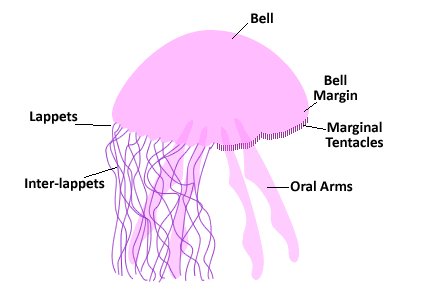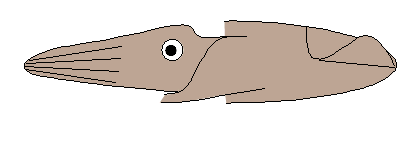
Jetting
Jetting is noticeably different from undulatory swimming and flapping flight, but in many ways it is simpler to understand. Some of the most familiar biological jetters are squid (cephalopods) and jellyfish (hydromedusae). Both propel themselves by accelerating a jet of fluid backward, causing them to move forward according to the reaction force from Newton's Third Law. Each has a unique way of generating the jet.
Jellyfish:

Jellyfish anatomy is very simple, making jellyfish propulsion rather easy to understand conceptually. Basically jellyfish consist of a bell that can be contracted (see the figure above). As the bell contracts, the volume of fluid inside the bell decreases, and the fluid must move out in order to satisfy conservation of mass. The result is a momentary pressure increase inside the bell that accelerates the fluid in the bell out of the orifice,forming a high velocity jet and accelerating the jellyfish in the opposite direction. In order to recharge, the jellyfish must reopen its bell and draw in new fluid. This process causes the jellyfish to slow or even begin moving backward (rebound). In order to minimize rebound, jellyfish tend to open their bells more slowly than they close them. This process is illustrated below with a video of swimming umbrella jellyfish (species Eutonina indicans) along with a digitized cross-section of one of the jellies, demonstrating the contraction and expansion process.
|
Swimming Umbrella Jellyfish (Eutonina indicans). Umbrella jellies are small (25-35 mm in diameter). They can be found in the Pacific Ocean coastal waters from California up to Japan and Russia. Video footage and animation courtesy of John O. Dabiri (Caltech)
|
|||
Although conceptually simple, analysis of jellyfish propulsion is actually quite complex. Because the propulsion strategy consists of pulses, the jet velocity is not constant in time and the pressure at the bell orifice is not ambient. Moreover, fluid is ingested and expelled from the same orifice rather than through separate inlets and exits as with mechanical turbojets. The video shown below illustrates these features with a small jellyfish (species Nemopsis bachei). The jellyfish has resting diameter of about 5 mm and the video plays about 8 times slower than real-time speed. Dye is injected around the jellyfish to make the jetflow visible. Notice that swirls of fluid (the aquatic version of a smoke ring) are ejected with each pulse. Pulses of swirling flow are clearly not the same as the steady stream of flow we used to describe turbojets.
|
Swimming Nemopsis bachei. Nemopsis bachei can be found in Atlantic coastal waters including eastern North America and Europe. Video footage courtesy of John O. Dabiri (Caltech) http://dabiri.caltech.edu in collaboration with John H. Costello (Providence College) http://www.providence.edu/bio/faculty/costello/ and Sean P. Colin (Roger Williams University) http://fox.rwu.edu/~scolin |
The intricacies of jellyfish propulsion prevents the thrust equation presented in the Principles section from giving accurate results because that equation was developed for a steady jet (no pulses) with a separate inlet and outlet. Nevertheless, the basic concept behind the thrust equation (i.e., acceleration of fluid to generate thrust) is still at work in jellyfish propulsion. For example, a faster bell contraction frequency leads to higher thrust due to a higher average jet velocity (increased fluid acceleration) and increasing the contraction frequency increases the average thrust because thrust is being generated more frequently. Said differently, the faster the swirls move away from the jellyfish and the more of them there are per second, the higher the average thrust. In a way, it's as if the jellyfish is throwing water balloons in one direction in order to create thrust in the other direction. More sophisticated analysis of jellyfish locomotion confirms these basic observations, but also indicates that the propulsive efficiency of jellyfish propulsion can be very low, on the order of 10%.
Squid:
A schematic of basic squid anatomy during jetting is shown below on the left. To propel itself, the squid expands its mantle cavity, drawing in fluid through the collar surrounding the head (shown in the middle below). When full, the squid closes the intake path and begins to contract the mantle. Mantle contraction pressurizes the fluid analogous to a compressor on a turbojet engine. The pressurized fluid is accelerated through the funnel (a tube-like nozzle), converting the fluid pressure to kinetic energy thereby creating a high velocity jet (shown on the right below). The squid is accelerated in the opposite direction of the jet. A movie of a shallow water brief squid (species Lolliguncula brevis) swimming into a steady current is available just below the schematics of squid jetting.
 |
 |
|
Swimming Brief Squid (Lolliguncula brevis). The squid is swimming at about 1 body length per second in this movie. Brief squid can be found in Atlantic coastal waters from Maryland down to Argentina. Video footage courtesy of Ian K. Bartol (Old Dominion University) |
Squid propulsion is similar to mechanical jet propulsion in that there is a separate inlet and exit, a chamber where fluid is pressurized, and a separate nozzle for accelerating the pressurized fluid to create a high-velocity jet. Nevertheless, significant differences still exist. First, the fluid inlet and exit are on the same side of the animal, instead of on opposite sides like a turbojet. Thus, squid not only speed the fluid up, they also change its direction during jetting. Yet, the flow velocity at the intake is much smaller than the jet velocity, so the intake process is not a dominant contributor to thrust. Second, the jet is unsteady, consisting of pulses like jellyfish propulsion. One consequence of this is the fluid pressure at the funnel exit is higher than ambient, leading to an extra boost in thrust (flow continues to accelerate as it exits the nozzle).
The unsteady character of the jet flow complicates the analysis of squid propulsion. Nevertheless, the basic observation that higher jet velocity leads to higher thrust still holds. Likewise, the larger the fraction of time the jet is on, the higher the average thrust (for a given jet velocity per pulse). The fraction of time that the jet is on (duty cycle) can be increased by either of two methods: (1) hold the volume of fluid ejected per pulse constant and increase the pulsing frequency, or (2) hold the pulsing frequency constant and increase the volume of fluid ejected per pulse (longer jet pulses). Observations of steadily swimming squid show that adult squid prefer to keep pulsing frequency constant and increase the volume of fluid ejected per pulse to increase cruise speed. Smaller juvenile squid have been observed to do the reverse, namely, increase in pulsing frequency while keeping the amount of ejected fluid per pulse constant in order to increase cruise speed. In either case, the large jet velocities achievable by squid lead to very respectable swimming speeds. Cruise velocities as high as several meters per second have been recorded.
To accelerate, squid quickly eject a pulse to achieve high jet velocity and large thrust. This is illustrated in the video below of a juvenile oval squid (species Sepioteuthis lessoniana) executing an escape jet. The video plays about 4 times slower than real speed, so the reaction of the squid is actually quite dramatic. The squid is startled a bit more than normal in this test, ejecting an ink cloud as it jets away.
|
Escape jet of a juvenile Oval Squid (Sepioteuthis lessoniana). The PVC pipe on the left is used to startle the squid and induce its escape jetting behavior. Oval squid are native to the Western Pacific. Video footage courtesy of Joseph T. Thompson (Franklin and Marshall College) |
While the above description highlights the primary mechanism of squid jet propulsion, it belies the incredible swimming versatility of squid. Squid are able to control the funnel orientation, allowing them to swim forward, backward, hover in place, or spin in a circle. The funnel configuration for backward (tail first) and forward (arms first) swimming are shown below. This is a highly versatile version of thrust vectoring similar to that used on the F-22 Raptor. Many squid also have fins on their mantle that undulate to assist in lift and thrust generation during low-speed swimming.

Fin contributions to propulsion make it difficult to assess the overall propulsive efficiency of squid propulsion, but considering the jet alone suggests squid propulsion follows trends similar to mechanical jet propulsion. Most notably, large jet velocities used by squid lead to lower propulsive efficiency at low swimming speed because a large fraction of the kinetic energy in the jet is left behind (wasted). As swimming speed increases, so does propulsive efficiency. Some estimates and measurements place the propulsive efficiency of the jet near 30-50% at low speed and 40-95% at high speeds (depending on the species). Recent measurements of squid jets during swimming also indicate that short jet pulses tend to be about 10% more efficient than long pulses, giving a certain advantage to the pulsed nature of squid propulsion.
